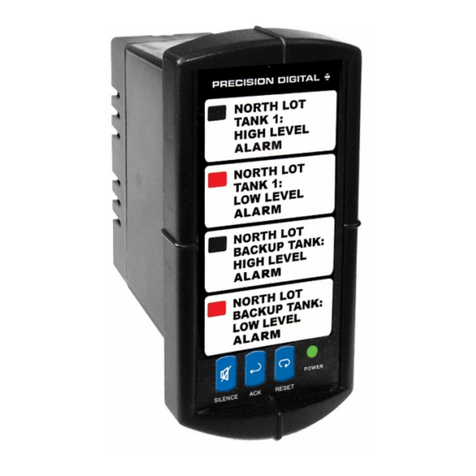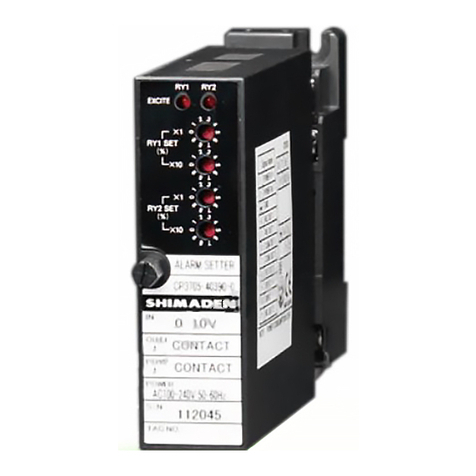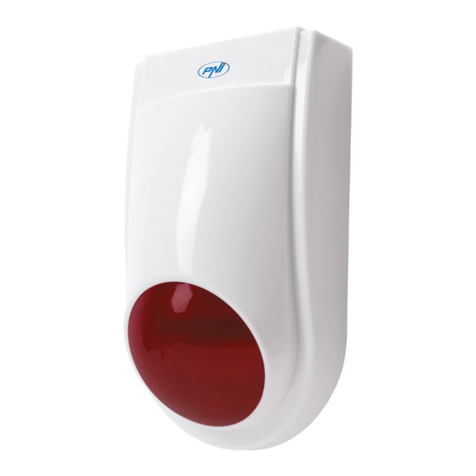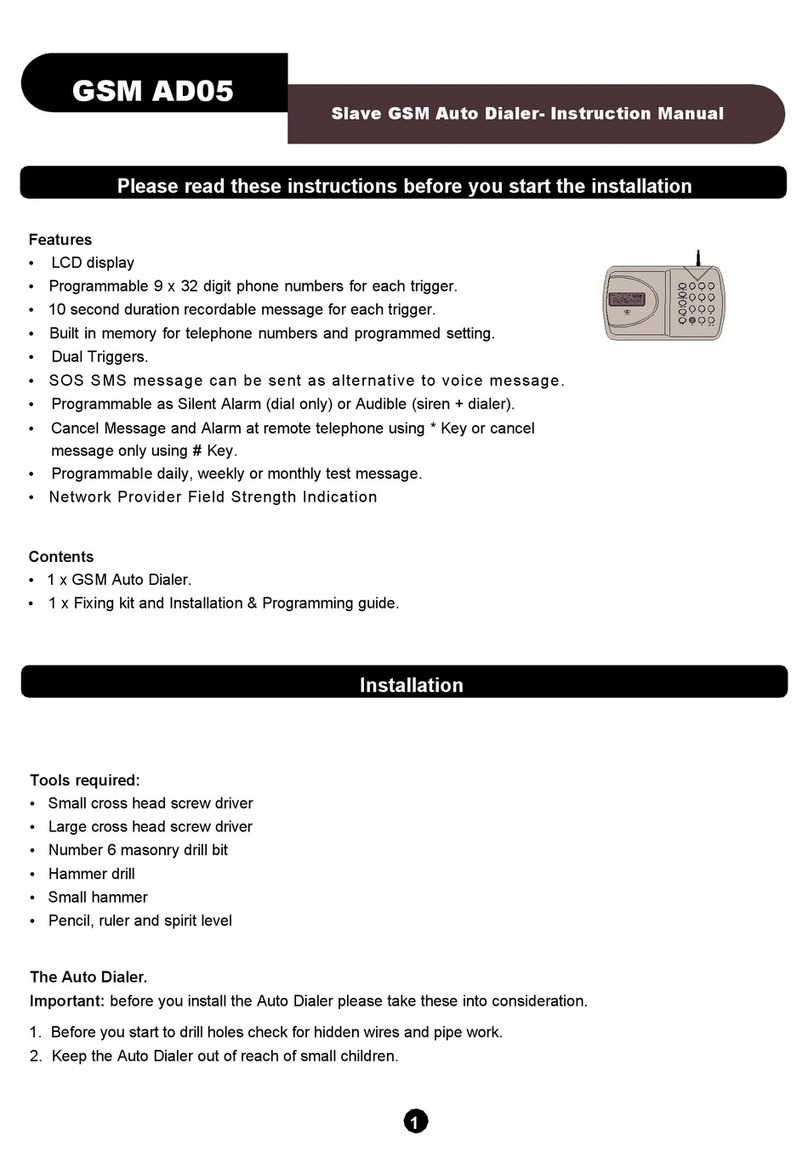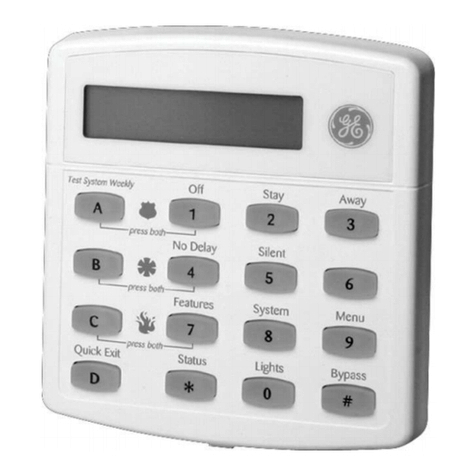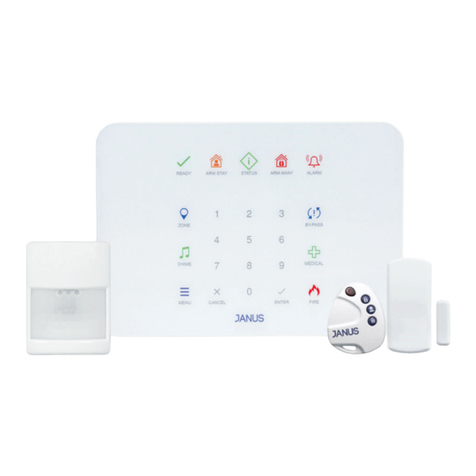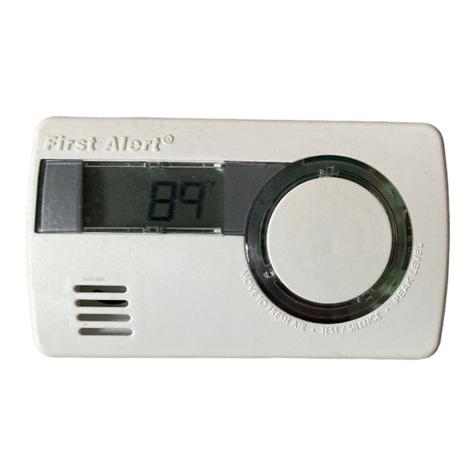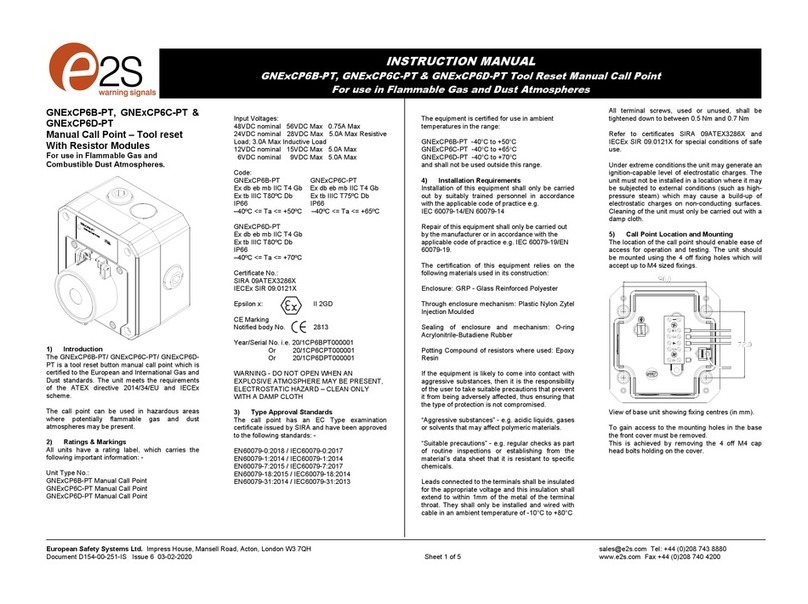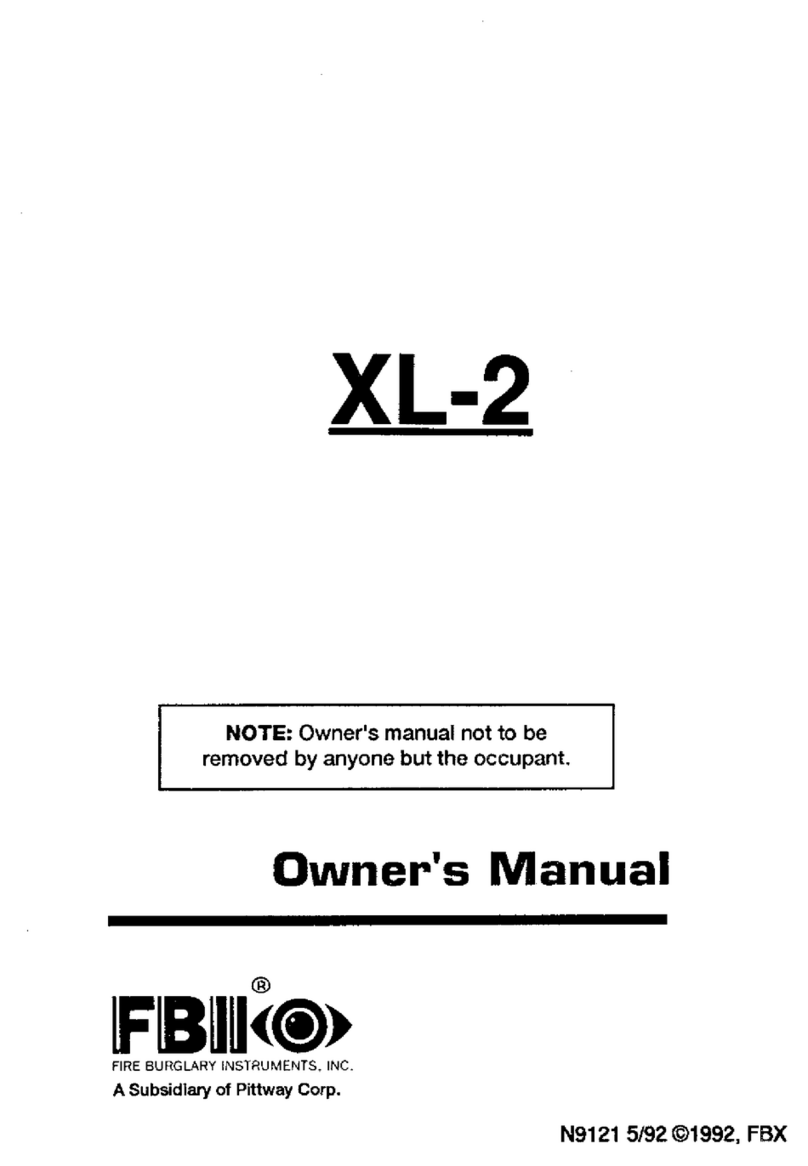Precision Digital Corporation VIGILANTE II User manual

PRECISION DIGITAL CORPORATION
89 October Hill Road • HollistonMA 01746 USA
Tel (800) 343-1001 • Fax (508) 655-8990 www.predig.com
PD154 & PD158
VIGILANTE®II ANNUNCIATORS
Instruction Manual
8 Field Selectable Sequences
All Common ISA Sequences
4 or 8-Point (Channel) Monitoring
Free Replaceable Message Labels
Type 4X, NEMA 4X, IP65 Front
Universal Power Supply 85-265 VAC
12-36 VDC/12-24 VAC Power Option
Built-In 85 dB Horn
2 SPDT Relays
24 VDC Isolated Power Supply (AC Models)
Multiple-Unit First-Out Indication
3 Pushbutton Operation
Sunlight Readable Indication
Monitor
up to 8
Inputs!

PD154 & PD158 Vigilante®II Annunciators Instruction Manual
2
INTRODUCTION
The Vigilante®II is a multipurpose panel mounted alarm annunciator. It
has 8 field selectable alarm sequences, including all common ISA
sequences. The alarm channels accept normally open, normally closed,
NPN open collector transistor, and logic level inputs. Three front panel
pushbuttons are used during sequence operation to silence the horn,
acknowledge the first out alarm, and reset cleared channels as required
by the sequences.
The Vigilante II has two SPDT relays that can be used for additional
external alarm indication, additional audible devices, or for process
control.
The isolated 24 VDC power supply available on 85-265 VAC models
can be used to power additional devices and external indicators.
Disclaimer
The information contained in this document is subject to change without
notice. Precision Digital makes no representations or warranties with respect
to the contents hereof, and specifically disclaims any implied warranties of
merchantability or fitness for a particular purpose.
Registered Trademarks
Vigilante®II is a registered trademark of Precision Digital Corporation. All other
trademarks mentioned in this document are the property of their respective
owners.
© 2010 Precision Digital Corporation. All rights reserved.
Visit our Web Site
http://www.predig.com

PD154 & PD158 Vigilante®II Annunciators Instruction Manual
3
ORDERING INFORMATION
85-265 VAC*
Model 12-36 VDC*
Model Description
PD154-6R2-1 PD154-7R2-0 Vigilante
®
II 4-Point Annunciator
PD158-6R2-1 PD158-7R2-0 Vigilante
®
II 8-Point Annunciator
*All models may be powered from AC or DC, see
Specifications for details.
Enclosures and Accessories
Model # of
Units Description Mounting
PDA2501-V 1 Plastic NEMA 4X Enclosure Through Door
PDA2502-V 2 Plastic NEMA 4X Enclosure Through Door
PDA2503-V 3 Plastic NEMA 4X Enclosure Through Door
PDA2504-V 4 Plastic NEMA 4X Enclosure Through Door
PDA2505-V 5 Plastic NEMA 4X Enclosure Through Door
PDA2506-V 6 Plastic NEMA 4X Enclosure Through Door
PDA2522 2 Plastic NEMA 4X Enclosure; 1(V) 1(H) Through Door
PDA2601-V 1 Stainless Steel NEMA 4X Enclosure Through Door
PDA2602-V 2 Stainless Steel NEMA 4X Enclosure Through Door
PDA2603-V 3 Stainless Steel NEMA 4X Enclosure Through Door
PDA2604-V 4 Stainless Steel NEMA 4X Enclosure Through Door
PDA2605-V 5 Stainless Steel NEMA 4X Enclosure Through Door
PDA2606-V 6 Stainless Steel NEMA 4X Enclosure Through Door
PDA2622 2 SS NEMA 4X Enclosure; 1(V) 1(H) Through Door
PDA2701-V 1 Steel NEMA 4 Enclosure Through Door
PDA2702-V 2 Steel NEMA 4 Enclosure Through Door
PDA2703-V 3 Steel NEMA 4 Enclosure Through Door
PDA2704-V 4 Steel NEMA 4 Enclosure Through Door
PDA2705-V 5 Steel NEMA 4 Enclosure Through Door
PDA2706-V 6 Steel NEMA 4 Enclosure Through Door
PDA2722 2 Steel NEMA 4 Enclosure; 1(V) 1(H) Through Door
PDA2801 1 Plastic NEMA 4X Enclosure Through Cover
PDX6901 Snubber 0.01μF, 470Ω, Flexible Leads

PD154 & PD158 Vigilante®II Annunciators Instruction Manual
4
QUICK SETUP GUIDE
The following overview details how to set up the annunciator for most
common uses.
Sequence Selection
The two most common sequences are ISA A and ISA F2A. Select the
sequence using the four-position switch on the rear of the unit above the
signal connector. For complete sequence details, see page 31.
ISA
A
ISA F2
A
NO/NC Inputs
Each input can be set for normally open (NO) or normally closed (NC)
contacts. Each input channel is programmed individually. The default
setting is for all inputs to be NO.
To set inputs to NC:
1. Press and hold ACK and RESET for 3 seconds until all LEDs
cycle.
2. Press ACK within 3 seconds of release. All LEDs will blink. If
ACK is not pressed within 3 seconds the unit will return to run
mode.
3. Press ACK again within 3 seconds of release. If ACK is not
pressed within 3 seconds the unit will return to run mode.
The LED for the channel being programmed will display brightly on or
off. All other channel indication LEDs will be at low intensity to indicate
programming mode.
4. Press the RESET pushbutton to turn LED 1 off for a NO input,
or on for a NC input for channel 1.
5. Press ACK to accept the input type and program channel 2.
6. Repeat steps 4 and 5 for all input channels.
7. Press and hold ACK for five seconds to return to normal
operation with the programmed input types.

PD154 & PD158 Vigilante®II Annunciators Instruction Manual
5
Basic Connections
All connections are made to removable screw terminal connectors
located at the rear of the instrument. For complete connection
details, see page 13.
!
Use copper wire with 60°C or 60/75°C insulation for all
line voltage connections. Observe all safety regulations.
Electrical wiring should be performed in accordance with
all applicable national, state, and local codes to prevent
damage to the instrument and ensure personnel safety.
Connector Labeling
The connectors label, affixed to the instrument, shows the location of all
connectors available with requested configuration. See Figure 2, page
13. Power Connections
Power connections are made to a two-terminal connector labeled
POWER. The instrument will operate regardless of DC polarity
connection. The + and - symbols are only a suggested wiring convention.
Signal Connections
Input signal connections are made to a 14-terminal connector at
terminals labeled INPUT CHANNELS. The COM (common) terminal is
the return for all input channels.
Normally Open (NO) or Normally Closed (NC) Switches
All channels are initially set for normally open contacts. Each contact is
wired across an input channel and common.
Relays and 24 V Output Connections
Relay connections are made to a six-terminal connector labeled
RELAY1, RELAY2. The COM (common) terminals of the relays should
not be confused with the COM (common) terminal of the signal
connector. The 24 VDC output is available at the connector labeled 24V
OUT, next to the relays connector.
Additional Information
For additional setup and wiring information, please see the complete
details further in this manual.

PD154 & PD158 Vigilante®II Annunciators Instruction Manual
6
Table of Contents
INTRODUCTION------------------------------------------------------------ 2
ORDERING INFORMATION--------------------------------------------- 3
QUICK SETUP GUIDE ---------------------------------------------------- 4
Sequence Selection--------------------------------------------------------------4
NO/NC Inputs ----------------------------------------------------------------------4
Basic Connections---------------------------------------------------------------5
SPECIFICATIONS---------------------------------------------------------- 8
General-------------------------------------------------------------------------------8
Inputs---------------------------------------------------------------------------------9
Relays --------------------------------------------------------------------------------9
COMPLIANCE INFORMATION----------------------------------------10
SAFETY INFORMATION ------------------------------------------------11
INSTALLATION------------------------------------------------------------12
Unpacking------------------------------------------------------------------------- 12
Panel Mounting------------------------------------------------------------------ 12
Connections---------------------------------------------------------------------- 13
Connector Labeling ---------------------------------------------------------- 13
Power Connections ---------------------------------------------------------- 13
Signal Connections ---------------------------------------------------------- 14
Relays and 24 V Output Connections----------------------------------- 15
Switching Inductive Loads-------------------------------------------------- 16
External Pushbutton Connections---------------------------------------- 17
Multiple Unit First-Out Indication Connections ------------------------ 17
SETUP AND PROGRAMMING ----------------------------------------18
Front Panel Pushbuttons and Status LED Indicators-------------- 19
Full Function Test-------------------------------------------------------------- 20
Multiple Unit First-Out Indication ----------------------------------------- 20
Shared Front Panel Buttons ------------------------------------------------ 20
Annunciator Sequence Selection----------------------------------------- 21
Sequence Programming---------------------------------------------------- 21
Sequence Descriptions ----------------------------------------------------- 21
Normally Open/Normally Closed Input Setup------------------------- 22
Programming NO/NC Inputs----------------------------------------------- 22
NO/NC Programming Example ------------------------------------------- 23
Relay Operation----------------------------------------------------------------- 24
Relay 1 Operation ------------------------------------------------------------ 24

PD154 & PD158 Vigilante®II Annunciators Instruction Manual
7
Relay 2 Operation ------------------------------------------------------------ 24
Relay Fail-Safe---------------------------------------------------------------- 24
Programming Relay Fail-Safe--------------------------------------------- 24
Relay Fail-Safe Programming Example -------------------------------- 25
Relay Operation Overview ------------------------------------------------- 26
Audible Horn Enable/Disable----------------------------------------------- 27
Enabling/Disabling Silence Option--------------------------------------- 27
No Lock-In Sequence Option----------------------------------------------- 28
Reset to Factory Defaults---------------------------------------------------- 28
MOUNTING DIMENSIONS----------------------------------------------29
TROUBLESHOOTING----------------------------------------------------30
FULL SEQUENCE DESCRIPTIONS----------------------------------31
Features ------------------------------------------------------------------------ 31
Sequence Condition Descriptions---------------------------------------- 31
LED Condition Descriptions------------------------------------------------ 31
ISA Sequence A----------------------------------------------------------------- 32
Relay Operation----------------------------------------------------------------- 32
ISA Sequence F2A ------------------------------------------------------------- 33
ISA Sequence F1A ------------------------------------------------------------- 34
ISA Sequence F3A ------------------------------------------------------------- 35
Sequence F3A Switch Positions------------------------------------------ 35
Input Follower Indication ---------------------------------------------------- 37
ISA Sequence M----------------------------------------------------------------- 37
ISA Sequence F1M------------------------------------------------------------- 38
ISA Sequence F2M------------------------------------------------------------- 39
Table of Figures
Figure 1. Panel Cutout and Mounting...............................................12
Figure 2. Connector Labeling for PD158-6R2-1 ...............................13
Figure 3. Power Connections............................................................13
Figure 4. NO/NC Contact Inputs........................................................14
Figure 5. Open Collector NPN Transistor Inputs.............................15
Figure 6. Relay & 24 V Output Connections.....................................15
Figure 7. AC and DC Loads Protection.............................................16
Figure 8. Low Voltage DC Loads Protection....................................16
Figure 9. External Pushbutton Connections....................................17
Figure 10. System with Multiple Units Share First-Out...................18
Figure 11. Shared Pushbutton Connections....................................20
Figure 12. DIP Switch Location.........................................................21
Figure 13. Case Dimensions – Side View.........................................29
Figure 14. Case Dimensions – Top View..........................................29

PD154 & PD158 Vigilante®II Annunciators Instruction Manual
8
SPECIFICATIONS
Except where noted all specifications apply to operation at +25°C.
General
DISPLAY PD154; Four red LED channel/point indicators.
PD158; Eight red LED channel/point indicators.
One green LED power indicator.
ALARM
MESSAGES Custom printed adhesive clear labels.
Area: PD154, 1.25" x .60" (32 mm x 15 mm), 4 messages
PD158, 1.25" x .25" (32 mm x 6 mm), 8 messages
User specified size and length, up to 4 lines (PD154) or 2
lines (PD158) of 14 characters of size 9 fonts.
PROGRAMMING
METHODS Rear 4-position switch for sequence selection and horn
operation. Three front panel pushbuttons for NO/NC input
selection, sequence options, and sequence operation.
NOISE FILTER 40 ms debounce on inputs (including SIL, ACK, and RST).
SHARED FIRST-
OUT SYSTEMS 1 ms unit-to-unit delay. Maximum of 200 units in the
shared first-out system.
NON-VOLATILE
MEMORY All programmed settings are stored in non-volatile memory
for a minimum of ten years if power is lost.
POWER
OPTIONS 85-265 VAC, 50/60 Hz
90-265 VDC, 20 W max
or 12-36 VDC, 12-24 VAC, 6 W max
FUSE Required external fuse: UL Recognized, 5 A max, slow
blow. Up to 6 annunciators may share one 5 A fuse
ISOLATED
POWER SUPPLY 24 VDC 10% @ 200 mA max
Standard on 85-265 VAC powered units only.
ISOLATION 4 kV input/output-to-power line.
OVERVOLTAGE
CATEGORY Installation Overvoltage Category II:
Local level with smaller transient overvoltages than
Installation Overvoltage Category III
ENVIRONMENTAL Operating temperature range: -40 to 65°C
Storage temperature range: -40 to 85°C
Relative humidity: 0 to 90% non-condensing
CONNECTIONS Removable screw terminal blocks for 12 to 22 AWG wire.
ENCLOSURE 1/8 DIN, high impact plastic, UL 94V-0, front color: black
MOUNTING 1/8 DIN panel cutout required. Two panel mounting
bracket assemblies provided.

PD154 & PD158 Vigilante®II Annunciators Instruction Manual
9
TIGHTENING
TORQUE Screw terminal connectors: Gray:4.5 lb-in (0.5 Nm)
Green: 5 lb-in (0.5 Nm)
OVERALL
DIMENSIONS 4.68" x 2.45" x 4.19" (62 mm x 119 mm x 106 mm)
(H x W x D)
WEIGHT 9.6 oz (272 g)
WARRANTY 3 years parts & labor
EXTENDED
WARRANTY 1 or 2 years, refer to the Price List for details.
Inputs
INPUT TYPES NO or NC switches: No external excitation required
Open collector transistor (NPN):
Open circuit voltage approximately 3.3 VDC
Logic Levels: LOW = 0 to 0.9 VDC
HIGH = 2.4 to 28 VDC
UPDATE RATE 41 ms following alarm state; 1 ms for alarm state clear
SEQUENCES Input follower, ISA Sequences A, F1A, F2A, F3A, M, F1M,
F2M and F3M per ISA Standard ISA-18.1-1979 R2004.
SEQUENCE
OPTIONS A, F1A, F2A, F3A, M, F1M, F2M, and input follower with
selectable options -1 (silence pushbutton), -4 (no lock-in),
and -6 (no horn) per ISA Standard ISA-18.1-1979 R2004.
Relays
RATING 2 SPDT (Form C); rated 3 A @ 30 VDC or 3 A @ 250 VAC
resistive load; 1/14 HP @ 125/250 VAC for inductive loads
ELECTRICAL
NOISE
SUPPRESSION
A suppressor (snubber) should be connected to each relay
contact switching inductive loads to prevent
disruption to the microprocessor’s operation.
Recommended suppressor value: 0.01 µF/470 , 250 VAC
(PDX6901).
RELAY
OPERATION Relay 1: Alarm state until alarm is acknowledged.
Relay 2: Alarm state while any channel indicating alarm
condition.
FAIL-SAFE
OPERATION Programmable
Independent for each relay
Note: In fail-safe mode, relay coil is energized in non-alarm
condition. In case of power failure, relay will go to alarm
state.

PD154 & PD158 Vigilante®II Annunciators Instruction Manual
10
COMPLIANCE INFORMATION
Safety
UL LISTED USA and Canada
UL 508 Industrial Control Equipment
UL FILE NUMBER E160849
FRONT PANEL UL Type 4X, NEMA 4X, IP65; panel gasket provided
LOW VOLTAGE
DIRECTIVE EN 61010-1:2001
Safety requirements for measurement, control, and
laboratory use
Electromagnetic Compatibility
EMISSIONS EN 55022:2006/A1:2007
Class A ITE emissions requirements
Radiated
Emissions Class A
AC Mains
Conducted
Emissions
Class A
IMMUNITY EN 61326-1:2006
Measurement, control, and laboratory equipment
EN 61000-6-2:2005
EMC heavy industrial generic immunity standard
RFI - Amplitude
Modulated 80 -1000 MHz 10 V/m 80% AM (1 kHz)
1.4 - 2.0 GHz 3 V/m 80% AM (1 kHz)
2.0 - 2.7 GHz 1 V/m 80% AM (1 kHz)
Electrical Fast
Transients ±2kV AC mains, ±1kV other
Electrostatic
Discharge ±4kV contact, ±8kV air
RFI - Conducted 10V, 0.15-80 MHz, 1kHz 80% AM
AC Surge ±2kV Common, ±1kV Differential
Surge 1KV (CM)
Power-Frequency
Magnetic Field 3 A/m 70%V for 0.5 period
Voltage Dips 40%V for 5 & 50 periods
70%V for 25 periods
Voltage
Interruptions <5%V for 250 periods

PD154 & PD158 Vigilante®II Annunciators Instruction Manual
11
SAFETY INFORMATION
!
CAUTION: Read complete
instructions prior to
installation and operation
of the instrument.
WARNING: Risk of
electric shock.
WARNING
Hazardous voltages exist within enclosure. Installation and service
should be performed only by trained service personnel.

PD154 & PD158 Vigilante®II Annunciators Instruction Manual
12
INSTALLATION
There is no need to remove the instrument from its case to
complete the installation, wiring, and setup.
Unpacking
Remove the instrument from box. Inspect the packaging and
contents for damage. Report damages, if any, to the carrier.
If any part is missing or the unit malfunctions, please contact
your supplier or the factory for assistance.
Panel Mounting
Prepare a standard 1/8 DIN vertical panel cutout – 1.772" x 3.622”
(45 mm x 92 mm). Refer to Figure 1 for more details.
Clearance: allow at least 4" (102 mm) behind the panel for wiring.
Panel thickness: 0.04" - 0.25" (1.0 mm - 6.4 mm).
Recommended minimum panel thickness to maintain Type 4X
rating: 0.06" (1.5 mm) steel panel, 0.16" (4.1 mm) plastic panel.
Remove the two mounting brackets provided with the meter (back-off
the two screws so that there is ¼" (6.4 mm) or less through the
bracket. Slide the bracket toward the front of the case and remove).
Insert the unit into the panel cutout.
Install mounting brackets and tighten the screws against the panel.
To achieve a proper seal, tighten the mounting bracket screws
evenly until the front is snug to the panel along its short side. DO
NOT OVER TIGHTEN, as the rear of the panel may be damaged.
Panel
Gasket
Mounting
Bracket Mounting
Screw
Removable
Connectors
1.772"
(45mm)
Panel Cutout
to DIN 43700
Square Corners
to 0.060"
(1.5mm)
Max Radius
B
Tolerances:
A: +0.032 (+0.8mm)
-0.000 (-0.0mm)
B: +0.024 (+0.6mm)
-0.000 (-0.0mm)
3.622"
(92mm)
A
Top ViewFront View
Figure 1. Panel Cutout and Mounting

PD154 & PD158 Vigilante®II Annunciators Instruction Manual
13
Connections
All connections are made to removable screw terminal connectors
located at the rear of the instrument.
!
Use copper wire with 60°C or 60/75°C insulation
for all line voltage connections. Observe all safety
regulations. Electrical wiring should be performed
in accordance with all applicable national, state,
and local codes to prevent damage to the
instrument and ensure personnel safety.
Connector Labeling
The connectors label, affixed to the instrument, shows the location of all
connectors available with requested configuration.
24V OUT
DW1837
POWER
INPUT CHANNELS
6587 4
CNONO NC NC C
RELAY2 RELAY1
P+ P-
+
213 COM ACK RST
12 43
FI FO
OFF
ON
SIL
Figure 2. Connector Labeling for PD158-6R2-1
Power Connections
Power connections are made to a two-terminal connector labeled
POWER on Figure 2. The instrument will operate regardless of DC
polarity connection. The + and - symbols are only a suggested wiring
convention.
AC or DC
POWER
Recommended External Fuse:
5 A max, Slow Blow
POWER CONNECTOR
+-
Figure 3. Power Connections

PD154 & PD158 Vigilante®II Annunciators Instruction Manual
14
Signal Connections
Input signal connections are made to a 14-terminal connector at
terminals labeled INPUT CHANNELS on Figure 2. The COM (common)
terminal is the return for all types of input signals.
Normally Open (NO) or Normally Closed (NC) Switches
The following figure shows an example of normally open or normally
closed contact inputs.
Programming a channel for a normally open or normally closed contact is
done with the front panel pushbuttons (see page 22). All channels are
initially set for normally open contacts. Each contact is wired across an
input channel and common.
COM
SIGNAL CONNECTOR
CH3 CH1CH2CH4
NO
CONTACT NC
CONTACT
Figure 4. NO/NC Contact Inputs
Open Collector NPN Transistor
Each transistor collector is connected to a separate input channel and all
emitters connected to common. All channels are factory set for transistor
inputs normally in the cutoff or ”off” state. For normally active/saturation
state or “on” transistors, program inputs for normally closed input
operation; see page 22.
Open circuit voltage is approximately 3.3 VDC provided by a 47 kΩ
internal pullup resistor.
The following figure shows an example of open collector NPN transistor
inputs.

PD154 & PD158 Vigilante®II Annunciators Instruction Manual
15
COM
SIGNAL CONNECTOR
CH3 CH1CH2CH4
NPN
Transistor
CBEC BE
Figure 5. Open Collector NPN Transistor Inputs
Logic Level Inputs
Each logic level input is connected to an input channel with common as
the return.
Logic level inputs are factory set for normally high active logic level inputs.
For normally low input logic levels, program inputs for normally closed
input operation, see page 22.
Logic Level Low: 0 to 1.4 VDC
Logic Level High: 1.5 to 28 VDC
Input Impedance: Approximately 47 kΩ
Relays and 24 V Output Connections
Relay connections are made to a six-terminal connector labeled
RELAY1, RELAY2 on Figure 2. The COM (common) terminals of the
relays should not be confused with the COM (common) terminal of the
signal connector. The 24 VDC output is available at the connector
labeled 24V OUT, next to the relays connector.
24V OUT
P+ P-
RELAY 2 RELAY 1
NC NCCNO CNO
Figure 6. Relay & 24 V Output Connections

PD154 & PD158 Vigilante®II Annunciators Instruction Manual
16
Switching Inductive Loads
The use of suppressors (snubbers) is strongly recommended when switching
inductive loads to prevent disrupting the microprocessor’s operation. The
suppressors also prolong the life of the relay contacts. Suppression can be
obtained with resistor-capacitor (RC) networks assembled by the user or
purchased as complete assemblies. Refer to the following circuits for RC network
assembly and installation:
RELAY 1
NC
NO
C
C
R
C
R
+
-
L
O
A
D
Figure 7. AC and DC Loads Protection
Choose R and C as follows:
R: 0.5 to 1 for each volt across the contacts
C: 0.5 to 1 µF for each amp through closed contacts
Notes:
1. Use capacitors rated for 250 VAC.
2. RC networks may affect load release time of solenoid loads. Check to
confirm proper operation.
3. Install the RC network at the meter's relay screw terminals. An RC network
may also be installed across the load. Experiment for best results.
RELAY 1
NC
NO
C
+
-
L
O
A
D
Figure 8. Low Voltage DC Loads Protection
RC Networks Available from Precision Digital
RC networks are available from Precision Digital and should be applied to each
relay contact switching an inductive load. Part number: PDX6901.
Use a diode with a reverse
breakdown voltage two to
three times the circuit
voltage and forward current
at least as large as the load
current.

PD154 & PD158 Vigilante®II Annunciators Instruction Manual
17
External Input Types
The external Silence (SIL), Acknowledge (ACK), and Reset (RST)
inputs may be: contacts (i.e. pushbuttons, relay contacts, etc), open
collector inputs (OC), or TTL signals. However, throughout this manual,
the term “pushbutton” is used to describe these external inputs. Please
refer to the chart below for signal logic.
External Input Type
A
ctive When
Switch/Contact Closed
Open Collector (OC) On
TTL Low
External Pushbutton Connections
The front panel pushbuttons may also be triggered with pushbuttons
connected to the signal connector terminals shown in Figure 2. Switch
SIL to common for the silence pushbutton, ACK to common for the
acknowledge pushbutton, and RST to common for the reset pushbutton.
The following figure shows external pushbutton wiring connections. Do
not wire-short the external pushbutton contacts to common.
INPUT CONNECTOR
SIL RSTACKCOM
Push-
Buttons
Figure 9. External Pushbutton Connections
Multiple Unit First-Out Indication Connections
Multiple PD158 and PD154 units can keep a single first-out channel
indicated for all connected units. An unlimited number of units may be
connected. It is recommended that all units follow the same sequence.
The following figure shows shared first-out indication wiring connections
for 3 units. Up to 200 units may be connected for first-out indication.

PD154 & PD158 Vigilante®II Annunciators Instruction Manual
18
UNIT 2
FI
SIL
RST
ACK
COM
FO
FI
SIL
RST
ACK
COM
FO
UNIT 1 UNIT 3
FI
SIL
RST
ACK
COM
FO
Figure 10. System with Multiple Units Share First-Out
SETUP AND PROGRAMMING
Overview
There are no jumpers involved in the setup process of the annunciator.
The sequence selector switch, located on the rear of the annunciator
above the signal connector must be set accordingly for annunciator
sequence desired.
Normally open or normally closed input setup, relay fail-safe, and
additional sequence options are programmed with the front panel
pushbuttons.
After power and signal connections have been completed and verified,
and the sequence selector switch has been set appropriately, apply
power to the annunciator.
For a
Quick Setup Guide
go to page 4

PD154 & PD158 Vigilante®II Annunciators Instruction Manual
19
Front Panel Pushbuttons and Status LED Indicators
Button Description
Silence Horn
Acknowledge
Alarm
Reset Clear
Input Channels
LED Description
Red
Indicators1Channel status
indicators
Green
Indicator Indicates power is on.
1. Quantity 4 red LED on the PD154
Quantity 8 red LED on the PD158
Pushbutton Descriptions
SILENCE
Silences the audible alarm without affecting the indication sequence
states. This pushbutton may be disabled (see page 27).
ACK (Acknowledge)
Acknowledges alarmed channels. See selected sequence details for
complete function description (see page 31).
RESET
Resets all acknowledged channels. This button is not used on ISA
sequences A, F1A, and F2A, which reset acknowledged channels
automatically. See selected sequence details for complete function
description (see page 31).
LED TEST (SILENCE & ACK)
Press and release the SILENCE and ACK pushbuttons to flash the
channel indicator LEDs for a lamp test.
SILENCE ACK RESET
POWER

PD154 & PD158 Vigilante®II Annunciators Instruction Manual
20
Full Function Test
Press and hold SILENCE and ACK for 5 seconds to perform a function
test. This tests the sequence operation and hardware by simulating
alarm inputs that are cleared in the normal sequence progression.
During the function test, all channels enter a simulated alarm state for 3
seconds. All LEDs, pushbuttons, relays, and the audible alarm will
follow the selected sequence as if the simulated alarm inputs were real.
After 3 seconds, the alarms may be cleared as normal for the selected
sequence.
Multiple Unit First-Out Indication
If multiple Vigilante II annunciators are connected for multiple unit
shared first-out indication (see page 17), only one input from all
connected devices will display as a first-out alarm.
Each individual annunciator will acknowledge and reset the channels on
that unit using the pushbuttons on that unit, and independent of all other
connected units. Only the unit displaying the first-out will sound the
audible alarm.
It is recommended that all connected units be set for the same first-out
sequence.
Shared Front Panel Buttons
To control all the units from any of the front panels, connect the SIL,
ACK, RST, and COM terminals on each unit.
SIL RSTACKCOM SIL RSTACKCOM
UNIT 1
SIGNAL CONNECTOR UNIT 2
SIGNAL CONNECTOR
Figure 11. Shared Pushbutton Connections
This manual suits for next models
2
Table of contents
Other Precision Digital Corporation Security System manuals
Popular Security System manuals by other brands
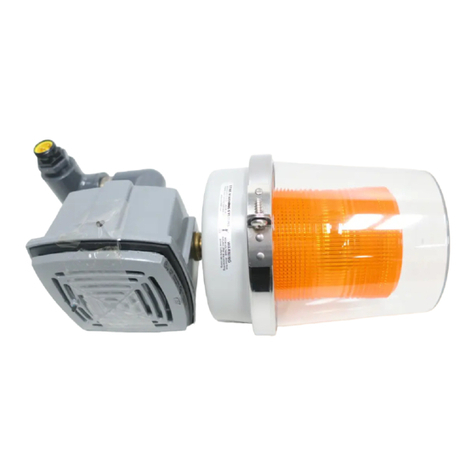
Bradley
Bradley S19-320A quick start guide

Honeywell
Honeywell Ademco Vista-48LA Programming guide
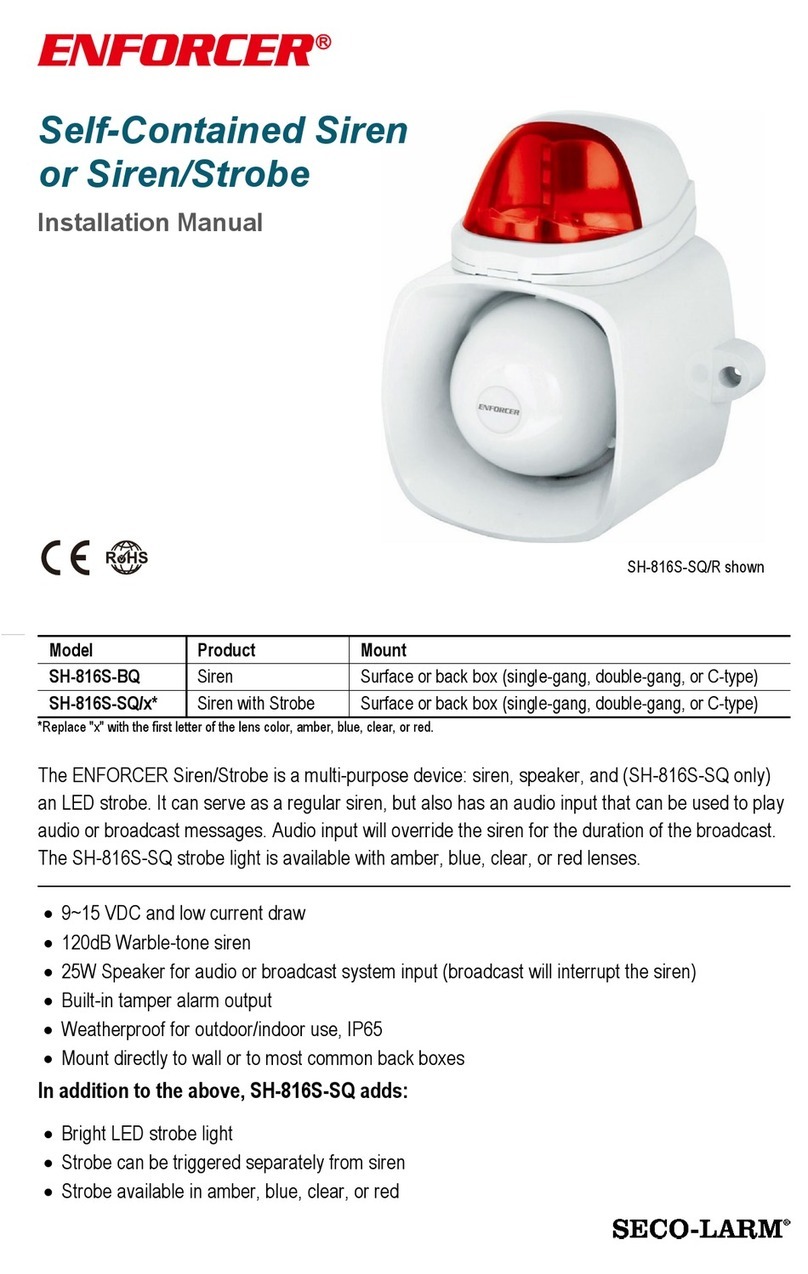
SECO-LARM
SECO-LARM ENFORCER SH-816S-SQ Series installation manual

Graham Field
Graham Field LUMEX GF13702 Setup & operation instructions
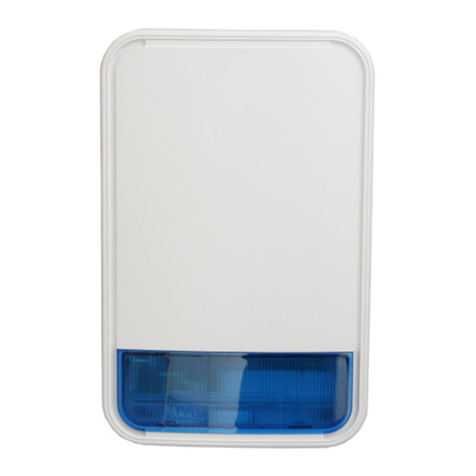
Visonic
Visonic MCS-730 installation instructions

DSC
DSC PC1510 installation manual
